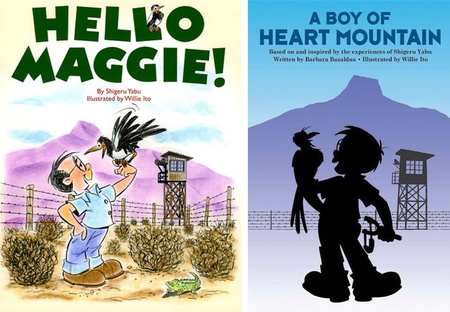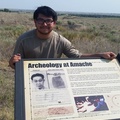One of my earliest childhood memories comes from being in what can rightfully be called a “concentration camp.” (Webster’s New World Fourth College Edition Dictionary: “A prison camp in which political dissidents, members of minority ethnic groups, etc. are confined.” Even President Franklin Delano Roosevelt and other top political leaders referred to them as concentration camps.
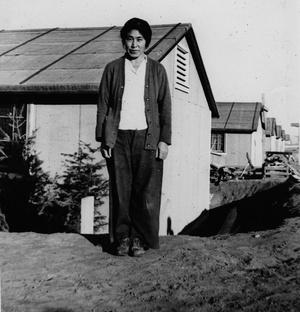
This photograph shows my grandmother, Owai Okamura outside our barrack. Notice the berm she’s standing on. It forms the “ditch” which I now believe, I jumped into.
In such a camp, nearing the age of 5, I remember panicking and jumping into a ditch to “escape” a dog near the barrack we lived in. Along with that haunting wisp of a memory, my pre-school teacher, Mae Fujikawa wrote in my November 4, 1944 report card under Emotional Control, “Gary fears dogs and gets upset easily.” These tidbits always kept me curious about dogs in camp and eventually inspired this essay.
Doggone it! We’d be justified to complain about being held wartime prisoners without due process of law. As Japanese descendants living in America at the outbreak of World War II, we were forcefully evacuated, relocated and imprisoned in our own country. Yes, America did imprison people because of their race for up to three years, and more for some. Yes, because Japan, our country of ancestral origin, attacked the U.S. Naval base in Pearl Harbor, Honolulu, Hawaii on December 7, 1941. But because of war hysteria, historically deep-seated anti-Asian animosity and economic opportunism—for all the wrong reasons—the U.S. Constitution was violated and justice was denied us. Two-thirds of us were U.S. citizens and a third denied citizenship outright! We were P.O.W. doggone it!
Dictionaries state that the phrase “doggone it” was a less profane way to say “goddamn it” and had nothing to do with dogs. But in the cases for many Japanese families at that time, dogs had a lot to do with it. Their dogs and other pets were forced to be separated from them because the U.S. government did not allow pets to remain with their soon to be uprooted families. These pets were part of the family! Can you imagine the confused and painful emotions felt by the animals and their human family members? Doggone it!
When Jerry Baba had to vacate his San Francisco, Nihon-machi (Japantown) home, he recalls the pain of having to watch their family dog, Fussy, being loaded into a locker on a dog-catcher truck and driven off. “I was crying. It was very traumatic for me as a kid.” Imagine the emotions of abandonment, confusion and fear that must have raced through Fussy’s mind. As for Jerry’s family, their feelings of helplessness and loss over being evacuated must have been extra stressful with the pangs of guilt and worry for what Fussy was going through. On top of all of this chaos, his mother was nearing full-term pregnant and expecting her third child!
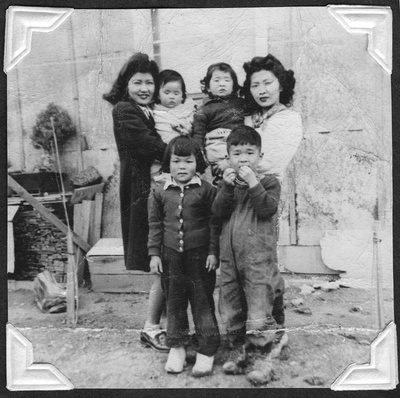
Jerry, front with mother, Haru (Nakajima) Baba behind him holding sister Aiko Jean. Friend, Misao Tsubokura (L) holding his other sister, Sachiko Carol, who was born two-weeks after their family was put into the Tanforan (Race track) Assembly Center. Haru Baba believes, the girl in front is Misao’s sister, Tamaki. They are shown in the Topaz, Utah, War Relocation Authority camp, ca 1942. (Photo courtesy of Haru Baba.)
Norman Y. Mineta, former cabinet member of two U.S. Presidents: Secretary of Commerce under Democratic President, Bill Clinton and Secretary of Transportation under Republican President, George W. Bush, told me how painfully sad it was to leave his dog when he was an 11-year-old boy. From the irony of his family facing the imminent evacuation from their home in San Jose, California in 1942, the San Jose International Airport today bears the name Norman Y. Mineta.
In his book, My Dog Teny, Yoshito Wayne Osaki of San Francisco touchingly tells about his traumatic ordeal of having to leave his pet Teny because of the forced evacuation. The story is beautifully illustrated by Felicia Hoshino, whose paintings sensitively and graphically conveys Wayne’s heart-wrenching story.
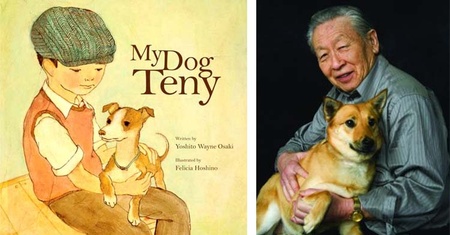
Book cover and photograph of Yoshito Wayne Osaki with Teny II. (Courtesy of Felicia Hoshino and Mr. Osaki and Mrs. Sally Osaki)
In her poignant novel, When the Emperor was Divine, Julie Otsuka tells how one Berkeley mother dealt with the dilemma of not being able to keep their pets under the pressure of the impending and questionable journey of relocation and imprisonment. Otsuka eloquently portrays how outwardly calm the protagonist seems in solving her problem with gaman (constrained determination), while the turmoil within her was palpable.
Shigeru Yabu, of Camarillo (by way of San Francisco), published two books: Hello Maggie written by himself and A Boy of Heart Mountain written by Barbara Bazaldua, a talented author of countless Disney children books. Willie Ito, the illustrator of Hello Maggie and A Boy of Hear Mountain, (also originally from San Francisco, now living in Monterey Park), is a well-known cartoonist who worked for Disney and then other movie companies. Later, Willie returned to Disney to tutor young Disney cartoonists worldwide until he retired.
“Shig” Yabu led a varied and interesting life eventually becoming the first executive director of the Boys and Girl Club in Camarillo. After retirement he joined his old S.F. Boys Scout buddy Willie Ito and began working on Hello Maggie, a heart-warming true story about raising a baby Magpie bird which became Shig’s camp pet in Heart Mountain. In his book, Shig tells about leaving his beloved dog, Skippy, turtle and goldfish behind and why he never found out what happened to them when he returned to San Francisco. A Boy of Heart Mountain is a novelized version of Shig’s camp experience beautifully written by Barbara Bazaldua. Shig Yabu says of her, “she sensitively captures all of the high and low emotions of my story.”
© 2012 Gary Ono



